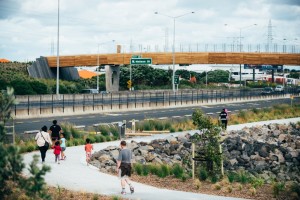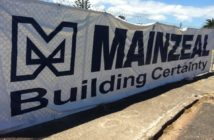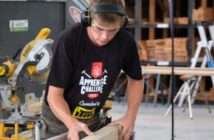The largest reclamation in the southern hemisphere built for purely recreational purposes can’t seem to stop collecting major awards
Auckland’s Onehunga Foreshore Restoration Project has garnered numerous accolades over the past couple of years, the most recent being the Isthmus Group winning the prestigious WAN Transport Award 2016 award for the Taumanu Reserve Bridge.
The $5 million bridge was a worthy winner of a WAN award that celebrates designs that are driving change within the transport sector – projects that not only enhance movement and access, but also advance social mobility and reinvigorate civic spaces, from trains and tram stations to airports and seaports.
Taumanu Reserve Bridge restores a connection to a re-imagined coastal landscape created after motorway development in the 1970s severed the local populace from the sea.
To resolve the problem of a park in two parts, a bridge of sufficient form and experience was required to stitch the halves together, with a legibility that was of the park and not the motorway.
Beautifully balanced and proportioned, the bridge moves into the adjacent constructed and planted landforms and abutments and is bookended by basaltic concrete panels.
The jury praised the resulting seamless integration of the bridge with the landscape, with Transport for London Technical Sponsor for River Crossings Catherine Hallett hailing the “innovative” design.
“It stands out, it does exactly what it says it’s going to do. It links to the beach, it looks like the beach.
“Beautiful to walk across, beautiful to look at, with function & form – it ticks all the boxes for me.”
Artwork on the bridge’s interior timber panelling was commissioned with guidance from the project’s Mana Whenua Maori advisors and undertaken by artist Bernard Makoare.
The resulting contemporary design was carved by machine, while in counterpoint anodized aluminium shells adorn the gateway upstands.
HOK Vice President Anthony Leslie was equally complimentary, appreciating the intricacy of the design.
“The detailing is fantastic. I think this project is beautiful and a very unusual and sensitive solution to a problem.”
Technical tasks
It wasn’t all plain sailing for urban and landscape design consultancy Isthmus, however, as Associate Sean Burke recalls.
“The bridge had some technical challenges in terms of spanning and providing sufficient clearance to SH20 as well as ensuring a balance with access grades and park footprint,” he explains.
“These problems disappeared with the introduction of a camber to the bridge, which as well as making it stronger provided a reveal sequence of the harbour as part of the user experience.”
In addition, a throw screen was added to the design brief late in the piece, which necessitated a reworking of the structural elements associated with the timber cladding as well as developing a concept for the throw screens themselves.
“Some innovative thinking from all parties, including the contractor and fabricator, allowed a solution to be found which met engineering and architectural objectives as well as fitting within budget,” Burke notes.
Installation of the bridge truss was a further logistical problem requiring a full motorway closure.
“The night lift was delayed twice due to high winds, but in the end it went without a hitch.”
Isthmus was well placed to handle this difficult project, having worked on a number of large-scale public realm projects over the past 30 years including the New Plymouth coastal walkway as well as Oriental Bay and Kumutoto in Wellington.
“We have also provided technical input into roading and energy infrastructure through the consenting, design and build phases across many projects such as the North Island Grid Upgrade, Tauhara ll and the Waitahora Windfarm,” Burke adds.
“In addition, we have completed a number of smaller bridge projects, including the Te Puru bridge as part of the Beachland to Maraetai coastal walkway, and feature bridges for Hobsonville Point.”
The project had a long gestation Burke explains, beginning in the late 1970s with the construction of the first SH20 – although the proposed duplication in the mid-2000s brought community dissatisfaction to a head.
The community successfully argued for the park proposed in the 1970s to be built and funded by NZTA and Auckland Council.
“Our involvement began in about 2009 and the wider foreshore project commenced in 2010 and was completed, including the bridge, in 2015,” Burke says.
“All in all it was an excellent example of a five-year collaborative effort by the Fulton Hogan Consortium, which also included Tonkin + Taylor, as well as bridge design sub consultants Aecom, with bridge fabrication being undertaken by Eastbridge.”
Isthmus continue to hone its Taumanu Reserve Bridge urban and landscape design skills working on a wide variety of projects, including several for the Transport Agency.
“We undertake a wide variety of work, including in the housing space with Hobsonville Point, but also urban work such as the Freyberg Square upgrade and park development such as Barry Curtis Park,” Burke adds.
Little wonder then that Isthmus had been shortlisted for WAN awards previously with Barry Curtis Park and was one of the final candidates in the Infrastructure category of this year’s WAN award – again for Taumanu Reserve Bridge.
“We have also just won the World Architecture Festival Landscape Award for Kopupaka Park at Westgate for Auckland Council, while the New Plymouth walkway also won an International Federation of Landscape Architects award some 10 years ago,” Burke notes.
Engineering excellence
The Onehunga Foreshore Restoration Project was itself an award winner, having previously been recognised with one of engineering’s most prestigious awards – the IPENZ Arthur Mead Environment & Sustainability Award.
The IPENZ judges’ award citation was complimentary of the project now known as Taumanu Reserve and the Fulton Hogan-led team that constructed it: “This project addresses the long-standing separation of the Onehunga community and a foreshore that was accessible and well used prior to the construction of the Southwestern Motorway,” they observed.
“Featuring basalt tongues, beaches and reduced access areas to provide habitat for avian wildlife, it capitalised on the enthusiasm of the community, and involved them to create a reserve and foreshore that gives the impression of having been naturally formed prior to the motorway construction. During land reclamation, the entrants pioneered a consent process that has been adopted by Auckland Council”.
Tonkin + Taylor acted as lead consultants for the Taumanu Reserve project, contributing hard engineering expertise along with environmental guidance and design coordination, Design Manager & Senior Civil Engineer Mark Foster explains.
“This was a unique project but similar undertakings with Isthmus include the Oriental Bay Foreshore redevelopment the Maratai to Beachlands Coastal Walkway that included the award-winningTe Pura Bridge and the New Plymouth Coastal Walkway,” he adds.
Some 25 staff were involved on what was one of environmental and engineering consultancy’s biggest undertakings as lead consultant on a lump sum project, although it is also working on the $1.4 billion Waterview Connection as one of three design consultancies involved in the Well-Connected Alliance that includes the NZ Transport Agency, Fletcher Construction, McConnell Dowell Constructors, Beca Infrastructure, Parsons Brinkerhoff and Obayashi Corporation.
Tonkin + Taylor was tasked with providing an exhaustive range of skills and services including:
- design management
- RMA planning
- obtaining resource consents for the 250,000m3 reclamation in the Manukau Harbour
- stakeholder management and consultation
- civil design
- pavement design
- structural design
- coastal processes assessment and plan form design
- coastal structures design
- earthworks and geometric design
- cycleway design
- stormwater design
- geotechnical design and liquefaction assessment
- geotechnical monitoring
- contaminated land assessments
- construction supervision
- marine and terrestrial ecology.
Regulatory restrictions
Given this extensive brief it’s little wonder that Taumanu posed several key challenges, the major one being the New Zealand regulatory context.
“The environmental regulations specifically discourage reclamation but this project required a large amount of reclamation so overcoming those hurdles was a major complexity,” Foster notes.
“We worked very closely with resource management planners to effectively tailor the design specifically to the legislation rather than shoehorning the design into the legal requirements, as often happens with other projects.”
Working with the coast was equally important as a key requirement was the restoration of the natural character of the coastlines.
“We basically built the project around restoring what was once lost – we strove for a natural-looking project so everything was designed to look as if it was always there and not man-made,” Foster explains.
“Without that approach it would have been tricky to get a resource consent.”
The other key complexity was the fact that the project had been initiated and driven by the community and therefore had a wide range of stakeholders, often with competing objectives that had to be delicately balanced.
The third key challenge was the difficult geotechnology. “Some parts had up to 10 metres of very soft soil while others were on rock, so it was tricky dealing with the challenges of the differing geology and ground conditions.”
Tonkin + Taylor successfully overcame these various challenges, designing a stunning reserve that includes:
- 4km of restored coastline
- 4 hectares of new parkland and beaches along a one-kilometre stretch of coastline
- extension of the existing parkland surrounding the Onehunga Lagoon
- a meandering shared-use path through the extensively landscaped parkland
- a series of rock headlands, three new sandy beaches and six gravel/shell pocket beaches
- a pedestrian path and cycle path along Orpheus Drive
- the Taumanu Bridge, a shared-use pedestrian/cycle bridge over SH20
- public amenities – boat ramp, toilet block, park furniture and a new carpark
- infrastructure upgrade of existing stormwater services including extension of the Onehunga Lagoon outlet culverts
- upgrade of Transpower’s pylon footing.
Needless to say, Taumanu provided Tonkin + Taylor with several key lessons that are standing it in good stead as it works on two similar projects on the Kapiti Coast and north of Auckland, both of which also include a seawall and a coastal walkway.
“The main lesson for us was using the legal framework to provide a really good basis for steering the design, which came to fruition thanks to our really collaborative approach with Isthmus,” Foster maintains.
“We chose to go with a highly collaborative, highly integrated approach to the design and it really bore fruit.”
The Onehunga Foreshore Project proved equally instructive for Head Contractor Fulton Hogan, as Project Manager Nariman Behzadi explains.
“It was a major undertaking that demanded a core engineering team consisting of four permanent staff on site and three senior managers off site,” he says.
“In addition, there were six on the structures team and up to 20 operators handling the earthworks, which saw 180-200 truck movements per day at the height of the earthworks season.”
Behzadi was personally involved in the structure team, although the most difficult aspect of the project was finding new methodologies to build the bridge and innovative ways of reclaiming land.
“Creating an iconic bridge and park for the people of Onehunga was something a bit different for Fulton Hogan to be involved in and we are very proud of the result that our design partners and our construction teams have achieved.”
His team also learned a lot when it came to lifting the 84-metre-long bridge structure, which was fabricated in Napier, brought to the site and assembled before being lifted and placed using a 450-tonne Grove GMK 7450 mobile crane with 100t counterweight and MegaWingLift from NZ Cranes.
“The beam truss weighed 113 tonnes and used 96 per cent of the crane’s capacity, which required six months of detailed planning by the NZTA, NZ Cranes and the Auckland Motorway Alliance,” Behzadi recalls.
This challenge was further compounded by consent restrictions that meant any detours or lane closures could not add more than five minutes to the travel time of motorists to or from Auckland airport.
Several traffic analyses and studies were undertaken with Beca and the NZTA to ensure there would be no delays on what was a key arterial route to the airport.
“We estimated it would take us four to five hours to set up the crane offline before one lane was shut to enable us to do more work,” he explains.
“We would then shut the second lane and move the crane closer to the final position.”
The Fulton Hogan team was given a seven-hour window on the weekend to complete the demanding task in order to minimise the effect on the travelling public, but the lift itself was completed in four to five hours.
“We started at 7pm with a staged closure and had the crane on the road and the first section closed around 10 pm,” Behzadi reveals.
“The programme called for the beam to be placed around 3-3.30am, the crane dismantled by 5am and off the road at 5:30am but the lift started at 12 and the beam was placed by 1am.”
The task gave Behzadi and the Fulton Hogan team a new-found appreciation of the extensive preparations required for such big lifts.
“It took us six months’ work, which included modelling how the bridge was going to act once it was lifted using a single crane,” he recalls.
“Lifting at certain points results in a lot of flexing and bending, and the beam was so long it had to be supported on two jinker units.”
Meticulous modeling
The Fulton Hogan team therefore had to model the entire transport route to ascertain the best and most efficient method of getting the bridge to the lifting position.
“This also showed us what services such as street lights and fencing barriers needed to be shifted or removed ahead of time.”
The crane placement position straddled two high pressure gas lines servicing north Auckland, which in turn demanded close liaison with Vector, who were eventually placed on standby along with the fire brigade.
“We had to locate the entire length of gas line in the work area and include it in the model to ensure correct pressure loadings on the pipes.”
An added complication arose when the team found the task couldn’t get the lift to work with one crane, having abandoned the original approach that required two cranes and would have taken at least two days.
“There was no way that could have been done in the seven-hour window allowed by the NZTA.”
As if that wasn’t enough, high winds caused the cancellation of the initial planned lift.
“The wind was gusting at up to 50km per hour, but the crane’s limit was 36km per hour due to its weight,” Behzadi says.
A rock concert meant the road couldn’t be closed on the second weekend while the wind disrupted the team’s carefully laid plans again on the third weekend.
“We had to wait right up until the night to make the call to go ahead with the lift.”
The frustration and delays were all worth it however, as the high-precision lift in December 2014 won Fulton Hogan both the Project of the Year and People’s Choice awards at the NZ Annual Crane Association Conference Awards.
“We are currently implementing the lessons learned on the Taumanu Bridge lift on a bridge site on the Albany Highway in Auckland’s North Shore involving a 40m, 70-ton load that is next to a school, gas line and a sewer,” Behzadi reveals.
The Taumanu Bridge project has clearly not only spawned several award-winning concepts, but also laid the foundation for further cost-effective development of similar New Zealand infrastructure in future.



